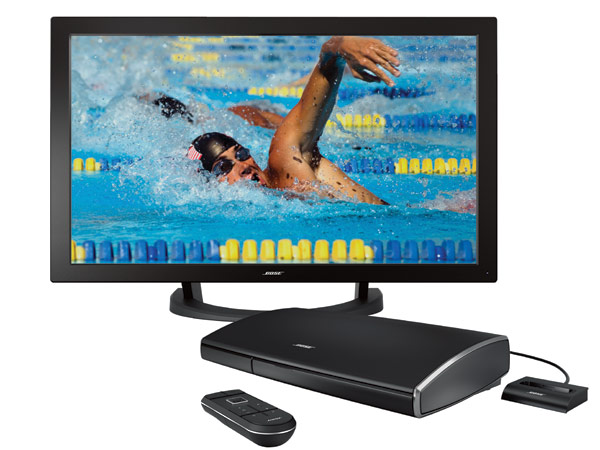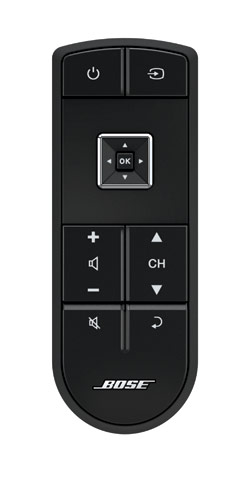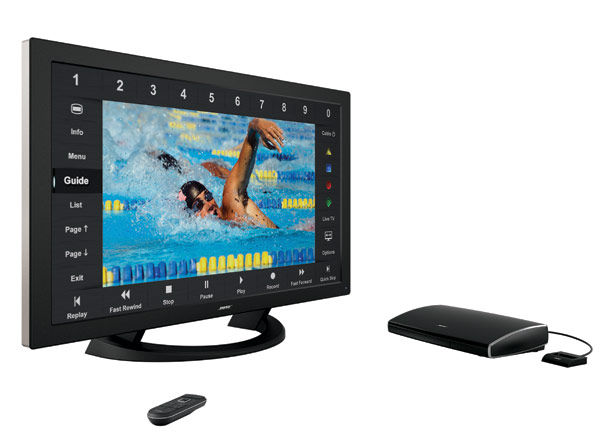Bose VideoWave Condenses Surround Sound Speakers into Compact TV

Known for its prowess in the realm of audio, Bose's signature move is to condense high-power sound into a single device. If you've seen and heard the Bose Wave Radio, you're familiar with the stature of audio quality that pours out from a standalone device that sits on top of your table or desk.
Well the company's playing the convergence game again, this time with television sets and the myriad gadgets you plug into them: surround sound speakers, a DVR, cablebox, iPod, or Apple TV unit. The VideoWave entertainment system, demoed by Bose today in New York, doesn't melt all those devices down into one TV set, but it does give you a simplified, cakewalk-easy means to integrate them into your home entertainment system. How? By building a TV set that doesn't need external speakers to deliver room-blanketing, cinema-esque audio and, thoughtfully enough, by meshing the controls for up to five entertainment gadgets (Blu-ray player, cable set-top, video game console, etc) into an interface that you can control with one remote.
Here's what the $5,349 VideoWave Entertainment System bundles in:
- 46" 1080p LCD TV with six woofers, a seven-speaker array, and advanced Bose digital sound processing built into the frame of television
- A Bose VideoWave console that connects to the television through a single wire (and can be used to connect other devices like your cable box, DVR, and more).
- An iPod/iPhone dock
- a proprietary, universal remote

The remote control interface is simple and intuitive. The term "universal remote" tends to bring to mind confusing devices that look like this. In fact, most home theater owners have given up on unifying controls, and they instead settle for using three or four separate remotes, each with probably upwards of 20 buttons. The Bose control wittles down all the functionality accessed through those devices to just 12 buttons: volume up and down, channel up and down, mute, back, power, mode, a four-way direction button with an OK key in the center, and a touch-sensitive click wheel.
The click-wheel allows users to access the more robust options found on standard remote controls. When touched, a menu appears along the edge of the display, surrounding video content that is minimized only as much as needed. To choose an option, the user slides their finger along the click-wheel, selecting menu buttons like play, pause, repeat, record, audio menu, etc as they need.
Bose has customized the menus found in DVRs, cable set-tops, gaming systems, iPods, and iPhones so that they work seamlessly with the VideoWave. Just plug in the peripheral device, use its included remote to key-in a few IR commands so that VideoWave system can familiarize itself, and then toss it.
This is home theater surround sound without the speaker setup. In order to recreate a 5.1 or 7.1 surround sound experience with a single-point audio system, Bose uses an in-house technology called Phase Guide that can "beam" sound to any point in a room, creating the effect that what is heard originated from that direction. When we listened to two battling jazz instrumentalists, it sounded as though a clarinet player was fighting from one corner of the room while a horn player attacked from the other. During a short video screening, the ambient noise of a New York City day sounded from above and the noise of country crickets surrounded us on the left and right.
Stay in the know with Laptop Mag
Get our in-depth reviews, helpful tips, great deals, and the biggest news stories delivered to your inbox.
High and low frequencies, too, covered a comfortable range. Bose attributes that bass quality to six high-performance woofers positioned back-to-back in an arrangement that cancels out internal vibration and dodges the risk of damage to the LCD display. Instead PhaseGuide is used to funnel sound out of the device and shot it to other points in the room.
Bose also bundles VideoWave with audio calibration software it calls ADAPTiQ that can factor in a room's shape and furnishings to better craft a powerful audio output experience. The thinking is no more speakers, no more wires, no more remotes, no more set-up.

Final Thoughts
Does VideoWave succeed in that endeavor? It gets very very close. Fussy families that want a beefier home entertainment rig but don't want the mess of wires and remote controls have a very compelling option. But if you're someone who watches content via your notebook, think before you buy. Bose told us that navigating notebooks required too rich a level of integration for the VideoWave interface and that if you want to watch Hulu on their TV, you'll be "driving from the notebook".
Still, two remote controls ain't bad.
On October 14, interested parties - and you too - can attend your own demo of VideoWave at any Bose store. If you like it, you can buy it too. The $5,349 asking price includes all the components we mentioned above, a detachable table-top stand, installation, device connection, ADAPTiQ calibration, and recycling of your old television.
Kenneth was a Social Media Editor at Laptop Mag. Outside of his limitless knowledge of social media, Kenneth also wrote about a number of tech-related innovations, including laptop reviews (such as the Dell XPS or the Acer Aspire) and even hands-on pieces about printers. Outside of Laptop Mag, Kenneth also worked at our sister site Tom's Guide.
